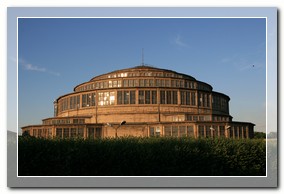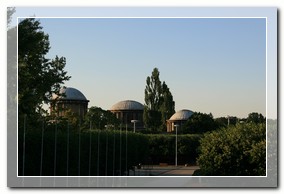


 s the only monument
in Wroclaw, which is written on the UNESCO list of World Heritage, the
Centennial Hall, called during the times of the communist Republic as
the Folk Hall, is one of the most impressive attractions in the region.
It was built in the years 1911–1913 according to the project of Max Berg
for a huge amount of 1,9 million marks, and it owes it's uncommonness
mostly to the reinforced cement copula, in the moment of creating the
largest in the world if it comes to spread — 67 m of the diameter (20 m
more than the Roman Pantheon). The hall has got 42 m of height, the
maximum width of it's interior is 95 meters, and the accessible surface
14 thousand square meters. Except the huge central hall in the building
56 different exhibition rooms were planned and spacious surrounding the
main hall lobbies. The hall could hold up to 10 thousands people.
According to the plan the construction was finished on time to celebrate
the hundredth anniversary of the battle near Leipzig (1813) with the
Century Exhibition.
s the only monument
in Wroclaw, which is written on the UNESCO list of World Heritage, the
Centennial Hall, called during the times of the communist Republic as
the Folk Hall, is one of the most impressive attractions in the region.
It was built in the years 1911–1913 according to the project of Max Berg
for a huge amount of 1,9 million marks, and it owes it's uncommonness
mostly to the reinforced cement copula, in the moment of creating the
largest in the world if it comes to spread — 67 m of the diameter (20 m
more than the Roman Pantheon). The hall has got 42 m of height, the
maximum width of it's interior is 95 meters, and the accessible surface
14 thousand square meters. Except the huge central hall in the building
56 different exhibition rooms were planned and spacious surrounding the
main hall lobbies. The hall could hold up to 10 thousands people.
According to the plan the construction was finished on time to celebrate
the hundredth anniversary of the battle near Leipzig (1813) with the
Century Exhibition.
During the construction of the Centennial Hall numerous different exhibition objects
were being made on the surrounding terrains, in this the Pavilion of
 Four Copulas and the Pergola, which has been decorated with an
impressive, costing one million zlotys fountain for sound and light
spectacles. In the Hall itself there were specially designed organs with
about 222 registers and 16706 pipes, during then these were the largest
in the world. Unfortunately they were damaged during the World War II.
The part which is undamaged is used at present in Wroclaw's arch-see.
Those organs are still the biggest in Poland. Together with the spire
and the surrounding buildings, for example the movie factory, the
Centennial Hall has become the symbol of Wroclaw.
Four Copulas and the Pergola, which has been decorated with an
impressive, costing one million zlotys fountain for sound and light
spectacles. In the Hall itself there were specially designed organs with
about 222 registers and 16706 pipes, during then these were the largest
in the world. Unfortunately they were damaged during the World War II.
The part which is undamaged is used at present in Wroclaw's arch-see.
Those organs are still the biggest in Poland. Together with the spire
and the surrounding buildings, for example the movie factory, the
Centennial Hall has become the symbol of Wroclaw.























